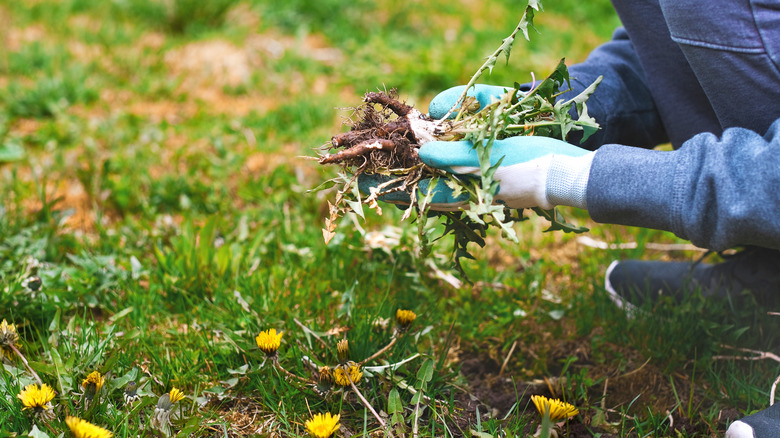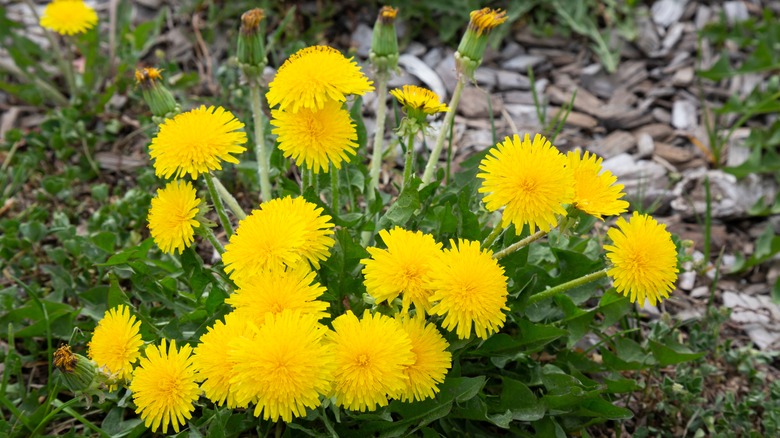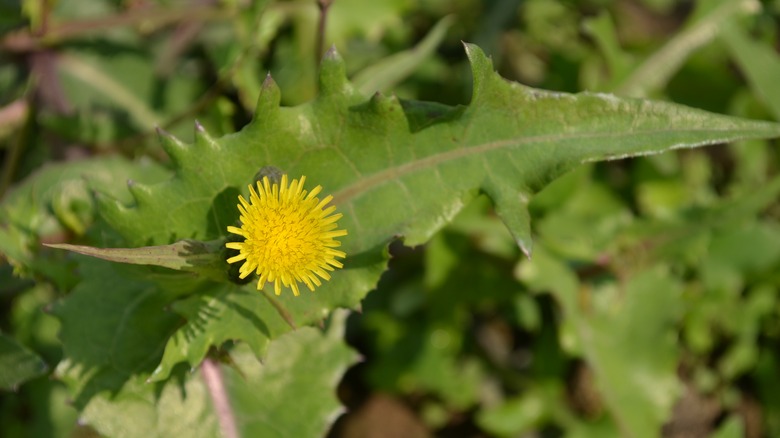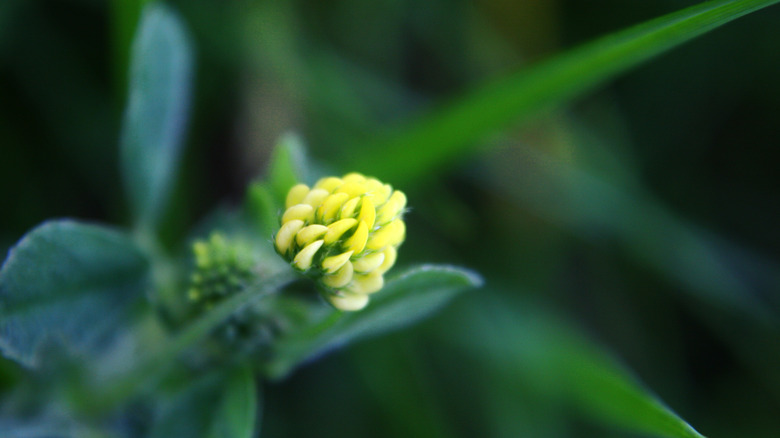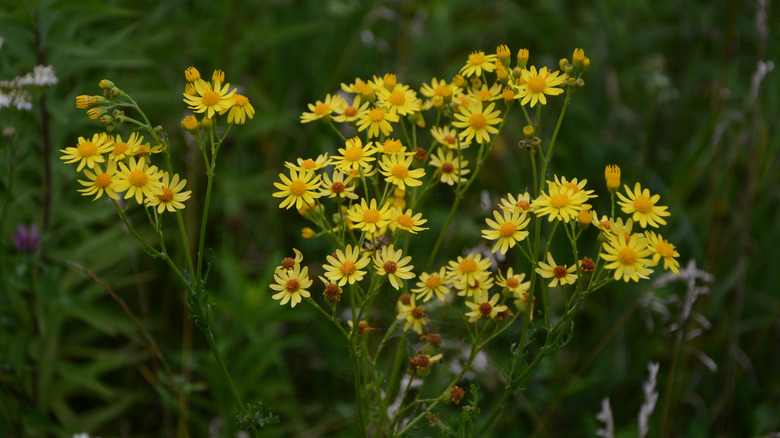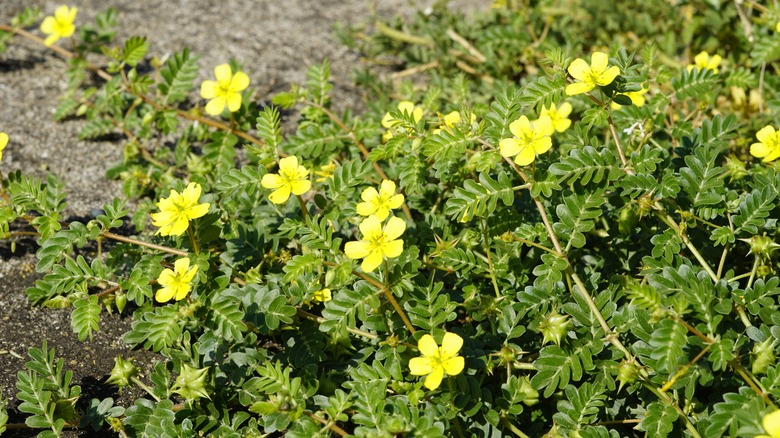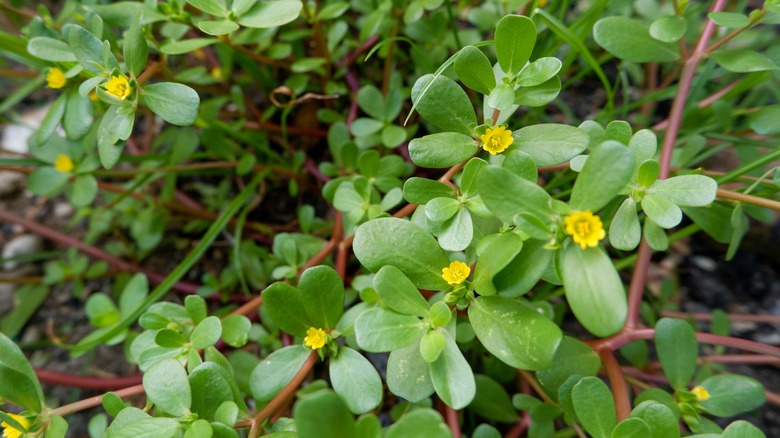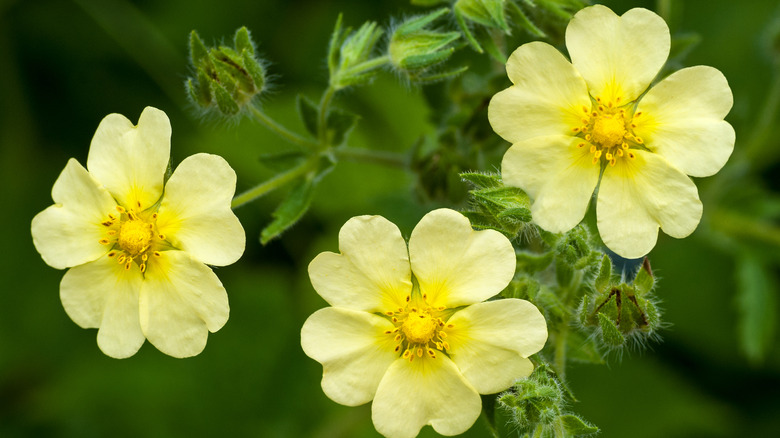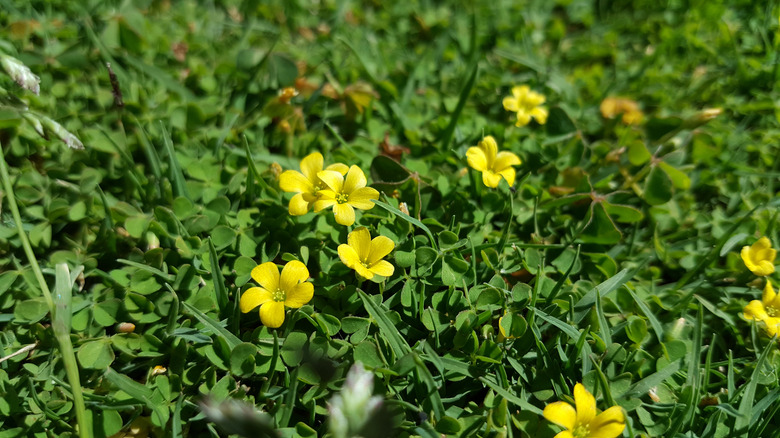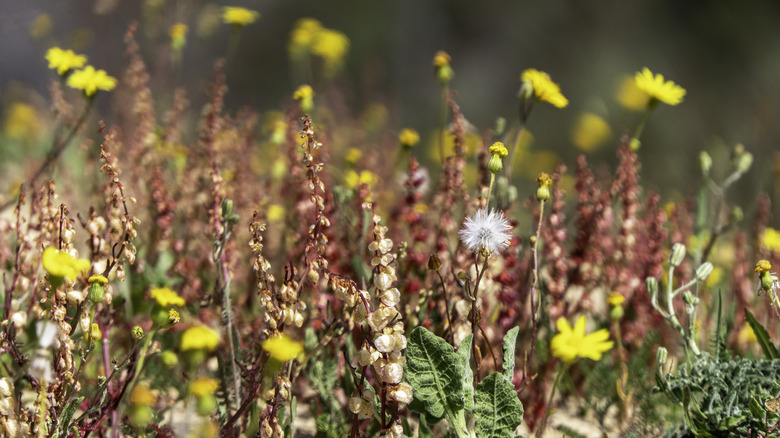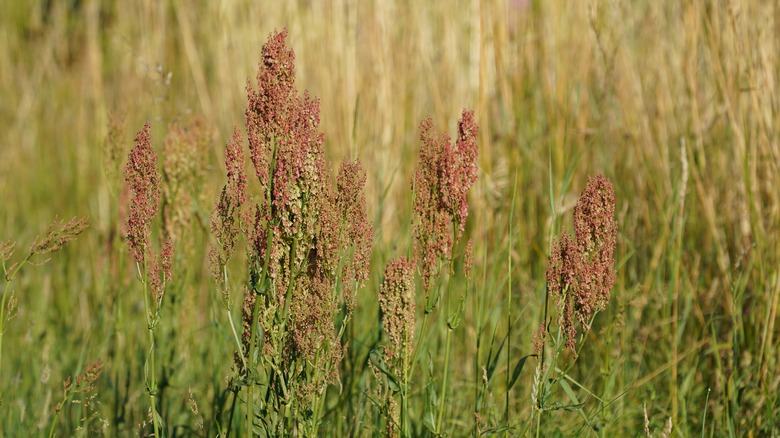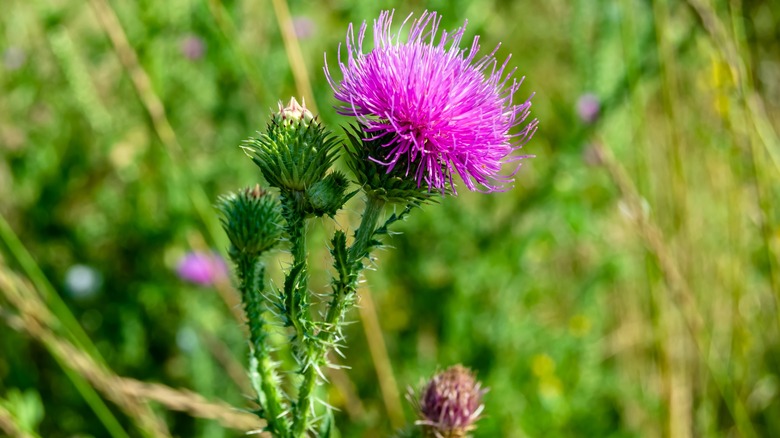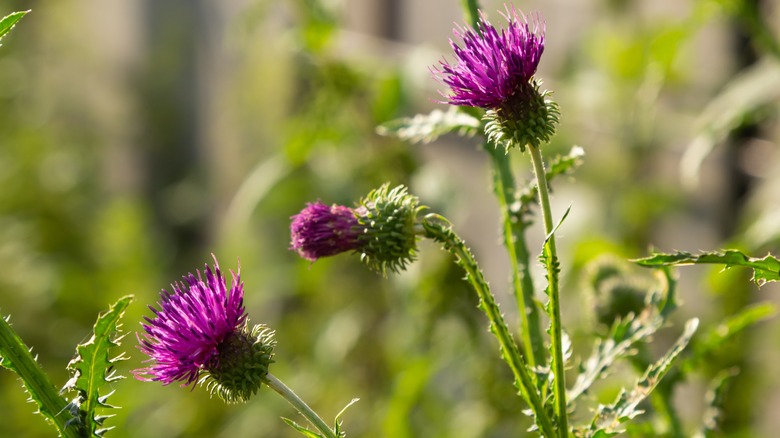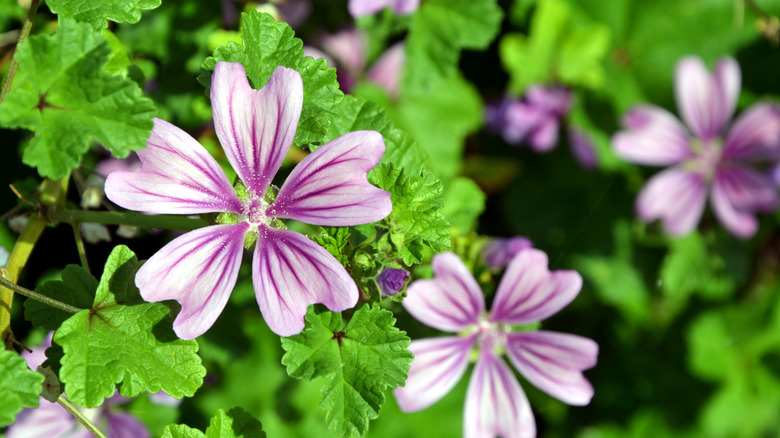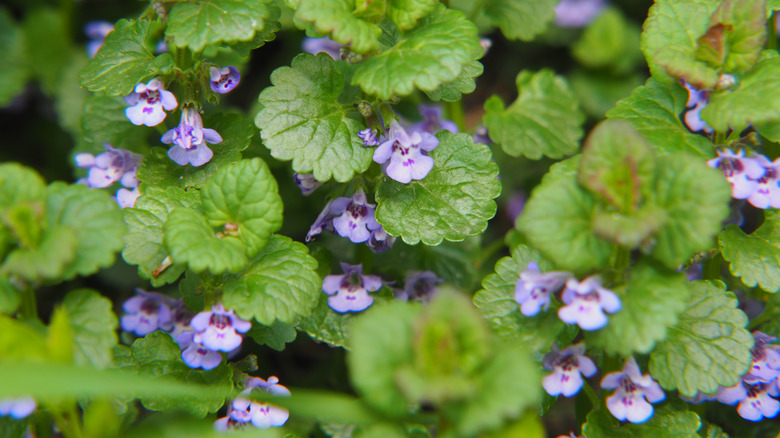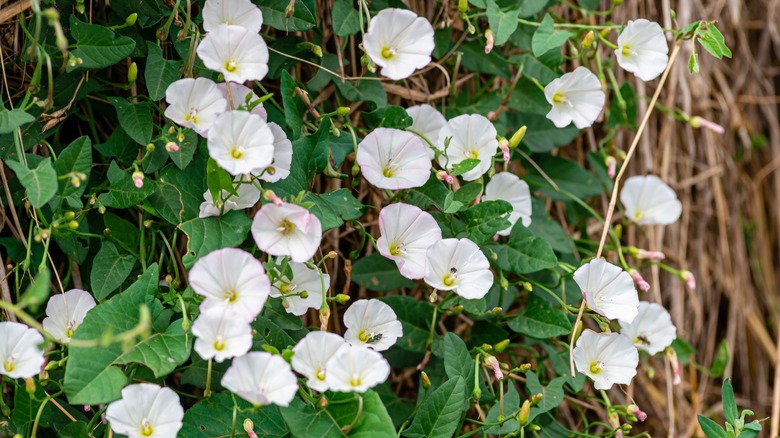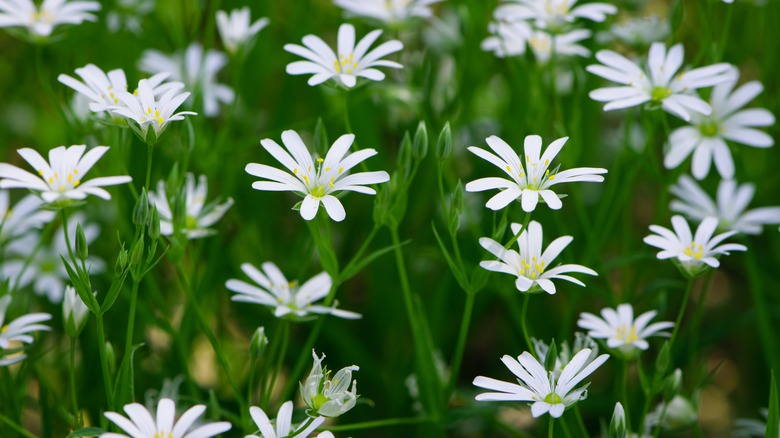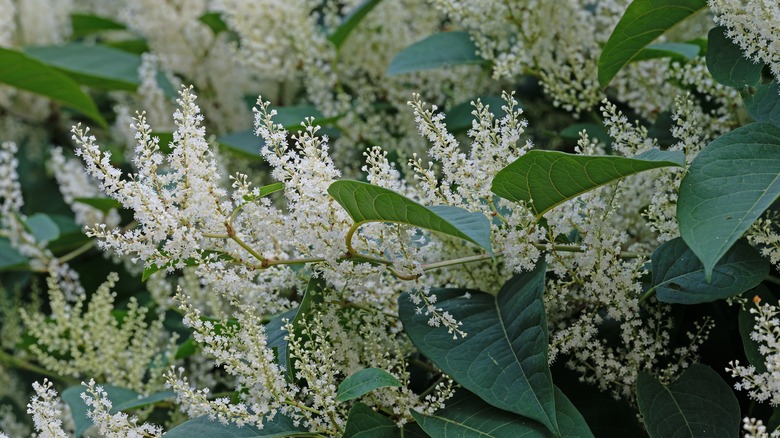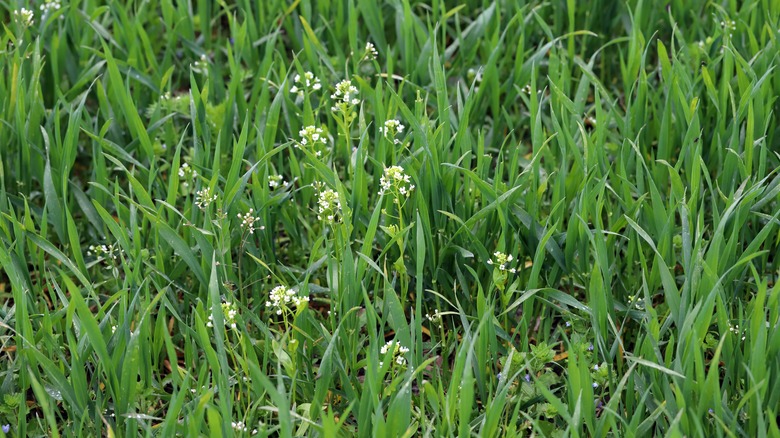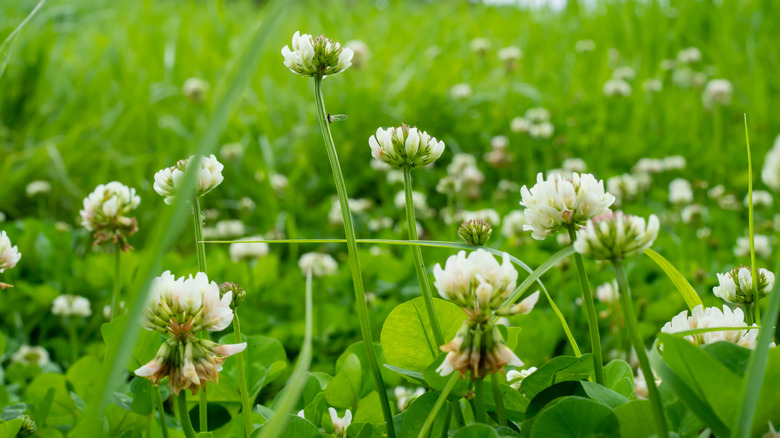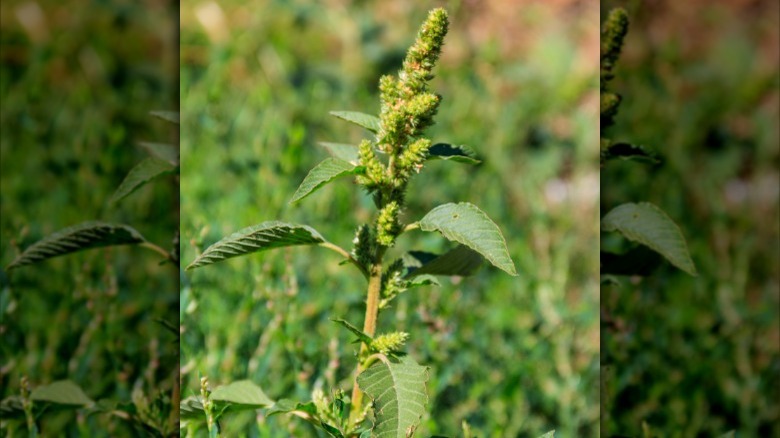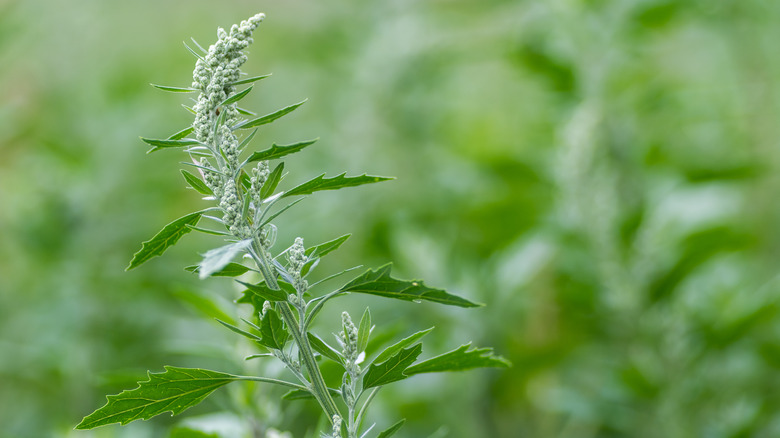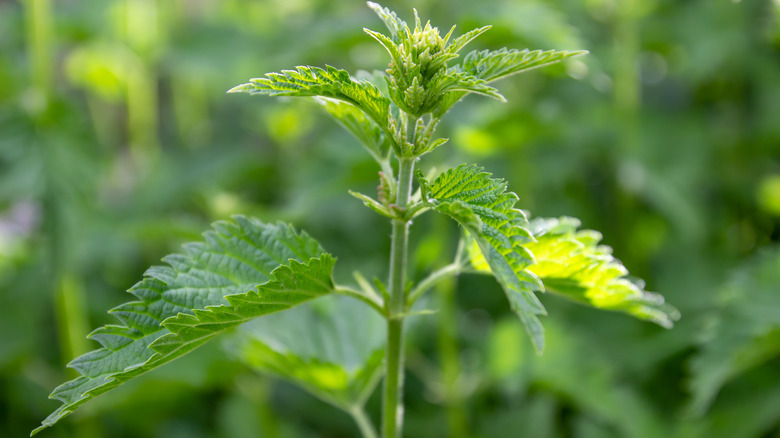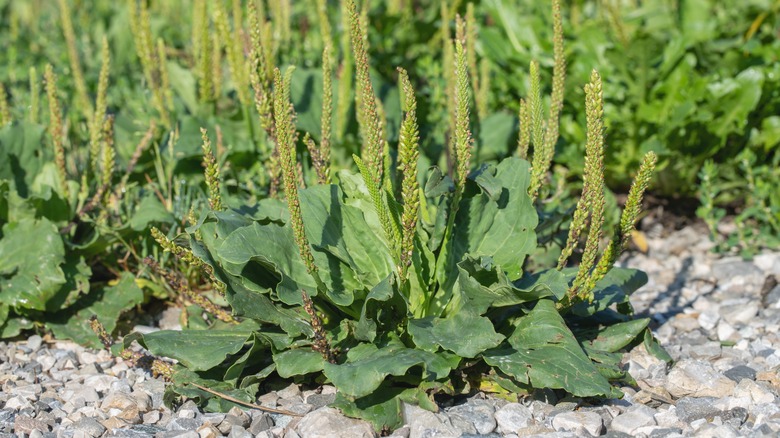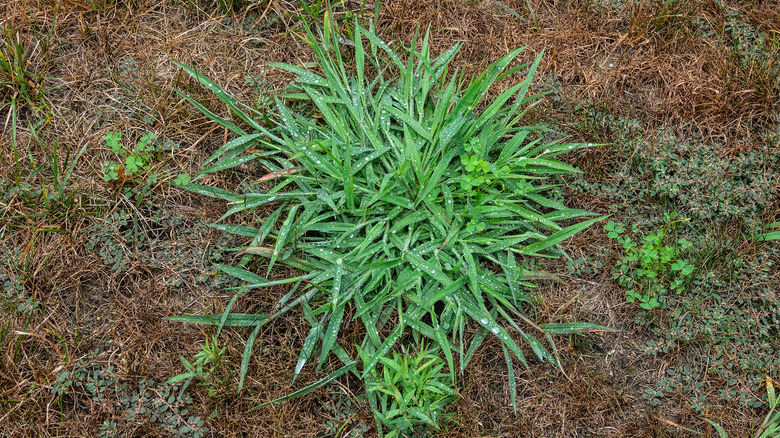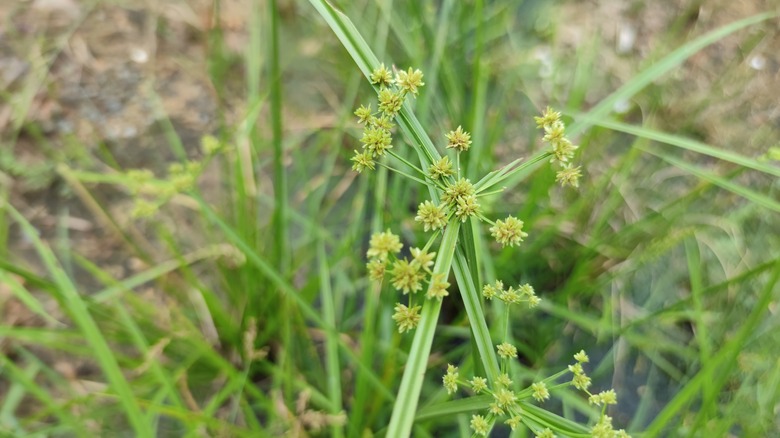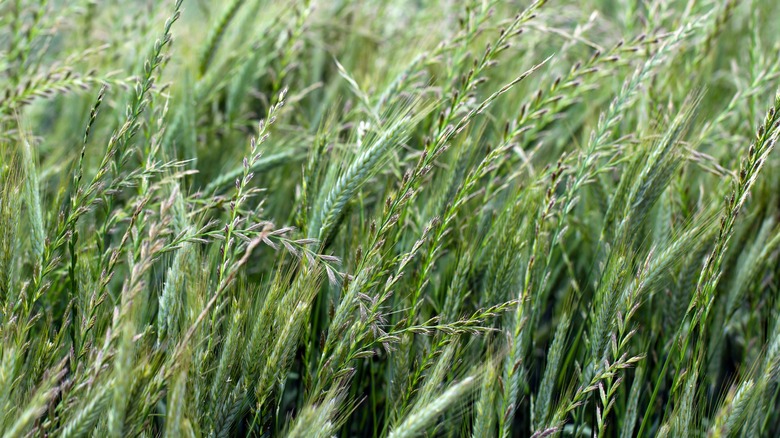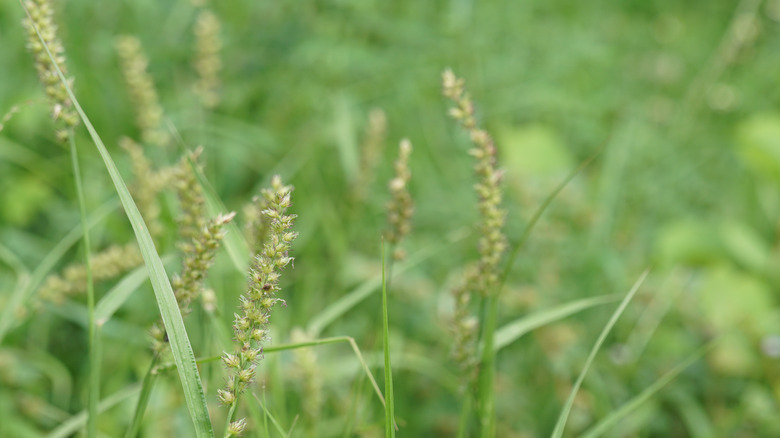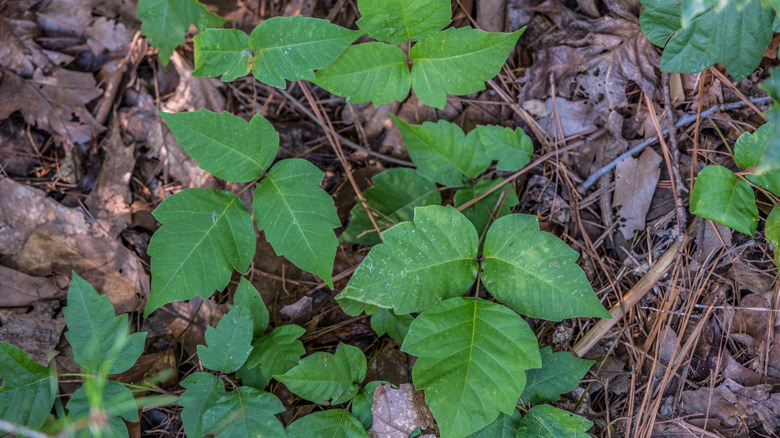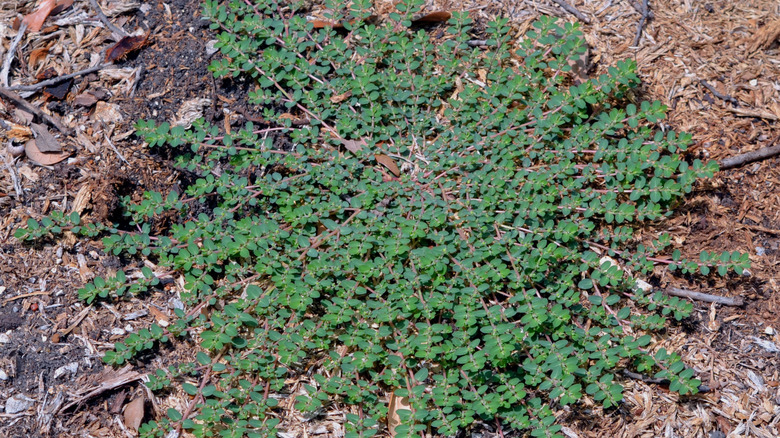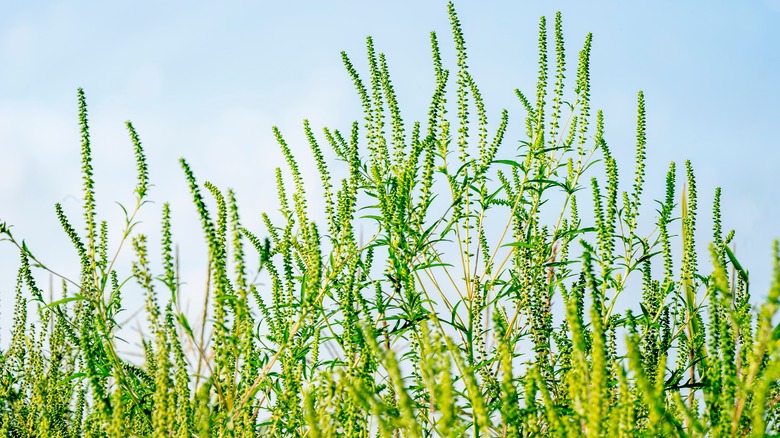30 Common Garden Weeds And How To Identify Them
One of the most dreaded gardening tasks requires lots of work: weeding. Because most weeds can damage the growth of plants, removing them from your garden is crucial. However, some folks may not be aware that certain types can actually be beneficial, either when kept in the ground or removed and consumed. Therefore, it's important to determine which species you're dealing with by knowing each of their distinguishing characteristics, as well as how to (or if you should) remove them.
Usually, the best way to extract weeds is by hand, by simply pulling them up and making sure you get all of the roots. When doing this, either wear gloves or use a weeding tool, such as a puller. If this doesn't work, or if you're dealing with a large field of weeds, you may want to spray an herbicide or DIY weed killer instead. Interestingly, some gardeners swear by pouring boiling water on unwanted weeds to kill them, but only do this if they are far away from any desirable plants you wish to keep.
1. Dandelion
An extremely common garden weed, the dandelion blooms yellow flowers that turn into white, puffy seed heads from spring to fall. Some choose to get rid of these weeds with either a puller or an herbicide because they can infiltrate a garden, but others keep them because their deep roots can prevent erosion and their flowers are beneficial for bees and birds. If you end up removing dandelions, their serrated leaves could be used in salads or sandwiches, and the roots are sometimes made into tea.
2. Annual sowthistle
While the spring and summer blooms of the annual sowthistle are similar to a dandelion and also become white seed heads, what sets this plant apart is that the stem is thicker and the leaves can have a blue to purple tint. Further, the seed head isn't round like the dandelion, but has more of a dome shape. While edible, this weed should be removed, as it can harbor pests that carry viruses. To extract if it hasn't gone to seed, use a hoe or hand pull; if it has gone to seed, kill it with an herbicide.
3. Black medic
Distinguishing characteristics of the summer or winter black medic include yellow flowers that turn into black seed pods, a hairy stem, and leaves that look similar to clovers. This weed should also be removed, as it could harbor insects and diseases. Extract it when the soil is wet by either hand pulling or using an herbicide. Know, too, that this weed could be a sign of nitrogen deficiency in your soil, and aerating could keep it away. If hand pulled, the flowers and leaves can be consumed and the seed pods can be turned into flour.
4. Common groundsel
The common groundsel should be carefully watched for in the spring and summer due to its toxicity for humans and animals; it can also cause root rot in your other plants. To identify groundsel, look for small yellow flowers with delicate petals and orange centers that turn into white seed heads; if they haven't bloomed yet, keep your eye out for their jagged leaves. Before the plant has bloomed, remove with a hoe or hand pull, but if it's already matured, use an herbicide.
5. Puncturevine
Blooming from spring to fall, the puncturevine can be identified by its light yellow flowers with five petals and small, hairy leaves. This weed earned its unique name because the flowers turn into sharp burs later in the season, which can easily cause punctures. For this reason, many landscapers choose to remove these plants before they harm people or animals. However, parts of the plant can actually be used for medicinal purposes. To eradicate this species, spray it with an herbicide.
6. Purslane
If you notice a low growing weed with tiny, yellow cup-shaped flowers that bloom in the spring and summer, you're most likely dealing with purslane. The round leaves are small and can have a rubbery feel, and they can be consumed in salads or on sandwiches. Some even believe that this plant can reduce the risk of heart disease, lower blood pressure, and improve skin, so you may want to keep it in the soil. However, if you want to remove it, hand pull or use an herbicide if you don't plan on eating it.
7. Rough cinquefoil
With light yellow heart-shaped petals and five-lobed leaves, the rough cinquefoil blooms in the summer and can tolerate many different types of soil. If you see this weed in your garden, know that it can be a sign of nutrient deficiency. Because it can quickly overtake plants, most decide to remove it by hand pulling. The leaves can then be eaten in salads or used for medicinal purposes.
8. Yellow woodsorrel
Growing low to the ground, the yellow woodsorrel has heart-shaped leaves that look like clovers and small, cupped blooms that open in the spring and summer, each with five petals. Woodsorrel is often found in open yards and dry areas, and it can quickly overtake your garden, so it's best to remove it with an herbicide. If you want to eat it, however, remove it by hand pulling; some say that it has a delicious, acidic taste.
9. Sheep sorrel
Easy to spot because of its vibrant colors, the sheep sorrel, which blooms from spring to fall, has a reddish tone and buttery yellow blooms. This weed could easily crowd a garden and is difficult to eradicate, as it will continue to grow back unless all the roots are removed. As with most weeds, you can either hand pull or use an herbicide on this plant. While toxic if eaten in large amounts, a few of the green leaves could be added to a salad.
10. Curly dock
Similar to the sheep sorrel, the curly dock weed has a reddish tone but doesn't produce yellow blooms, making it easy to distinguish. It also has shiny, bright and wavy leaves located at the base. This weed grows in moist, shaded soil from spring to fall. If you have livestock, remove curly dock immediately, as it's toxic to many animals (though edible for humans). It can be difficult to eradicate, so use a powerful herbicide.
11. Burdock
While burdock has beautiful purple-pink blooms, most decide to remove it from their garden, as the flowers will soon turn into sharp burs that could harm people and animals alike. Besides the flowers that bloom in the summer and early fall, this weed can be identified by its spiked stem. Once easily removed by hand pulling (be sure to wear gloves), the roots of this plant can either be eaten or used to make tea. Before it flowers, burdock can also be maintained by mowing.
12. Canada thistle
Similar in appearance to the burdock weed, the Canada thistle can have purple, pink, or white flowers that bloom in the summer and turn into seed heads instead of burs in the fall. This weed can also be identified by notched leaves, and it grows a few feet tall. Because it's invasive and steals nutrients from the plants around it, Canada thistle should be mowed over or sprayed with an herbicide. Once removed, you could cook with it, as every type of thistle is edible.
13. Common mallow
A beautiful weed, the common mallow can be identified by its heart-shaped, light purple flowers with a veined appearance and small, crinkled leaves. The flowers and leaves, which bloom in the summer and fall, are sometimes eaten after being hand pulled, though they can be toxic if consumed in large quantities. Because these weeds typically don't pose a threat to animals or other plants, you could keep them in your garden to add color and attract butterflies.
14. Ground ivy
Ground ivy has small, purple flowers that bloom in the spring and summer, as well as bright green leaves. Because this weed is part of the mint family, it grows fast and can completely overtake a garden. It's also toxic for animals, so it should be extracted quickly. To remove, use a strong herbicide, as it will continue to grow if even a tiny amount of the roots remains in the ground. If you wish to consume the pungent leaves, pick a few before eradicating it.
15. Field bindweed
The field bindweed's long stems have dark, pointed leaves and tiny white or pink blooms with yellow centers that appear in the summer and fall. It's often found in mowed yards or soil that has been disturbed. Because this weed is toxic to horses and will continue to grow if any root is left behind, it should be removed completely with herbicide. While some eat the leaves of this plant, they should only be consumed in very small amounts.
16. Chickweed
Often found in wet, dark, and cool areas, chickweed has hairy leaves, grows low to the ground in the fall, and blooms white flowers with narrow petals in the spring. This plant is often eaten in salads or other dishes because it contains lots of nutrients. However, because it can spread quickly and become infested with insects, most remove it from their gardens. To do so, either use an herbicide or hand pull all the roots.
17. Japanese knotweed
Easy to spot, Japanese knotweed has a hollow stem that branches out to support large, pointed leaves and tiny white or green flowers that bloom in the spring. This plant is so strong it can grow through concrete; it's also known to aggressively crowd out other plants. Extract it from your garden with glyphosate herbicide. As with the other edible weeds, you could remove some of the young plants to eat or use for medicinal purposes before you spray.
18. Shepherd's purse
Shepherd's purse is also quite easy to identify, as it has a unique appearance. The bottom of the plant has jagged leaves, while the middle has triangular pods, and the very top has small white flowers that can bloom in the spring, summer, and fall. This weed is edible and has been used for medicinal purposes in the past, but some states list it as an invasive species. To permanently remove it before it overtakes your garden, use an herbicide.
19. White clover
If you find a low growing plant with three-petaled leaves and white flowers blooming in the spring or the summer, you've come across the white clover. It's sometimes used to benefit landscaping, since it's so easy to take care of. Further, because bunnies love to munch on it, leaving it around your garden could keep them from destroying your produce. White clover can also be eaten by humans in moderation, though not in excess. If you want to remove it for aesthetics or another reason, use an herbicide.
20. Pigweed
Pigweed can be identified easily because it typically doesn't have any branches, just one tall stem from which large leaves and small green flowers grow in the summer and fall. If you see this weed in your garden, it could actually be a sign of fertile soil. However, it still should be removed because it will rob nutrients from your produce. Though the leaves and seeds can be eaten by humans, it's toxic for animals. To extract, hand pull or use a hoe before the plant matures.
21. Lamb's quarters
Lamb's quarters is similar to pigweed, but the leaves look quite different with jagged edges. Its flowers that bloom throughout summer and fall are often a light green tone. If you want to eat this weed, you could add the leaves to a salad or consume the seeds in small amounts. While it grows fast, this species doesn't typically harm other plants and could be kept in your garden. If you do prefer to extract it, simply remove it by hand.
22. Stinging nettle
Needle-thin hairs containing compounds that irritate the skin give the stinging nettle its apropos name. This weed can grow up to 4 feet tall and produces small green flowers in the summer. While painful if brushed up against, stinging nettles can actually be eaten by humans and animals, and used in natural medicines. Unfortunately, it can push out other plants and is considered invasive, so you may want to get it out of your garden. To do so, spray with systemic herbicide and be careful not to touch it with bare hands.
23. Broadleaf plantain
If you notice large, wavy leaves and tall seed stalks in the summer or fall, you're dealing with the broadleaf plantain, which is an invasive species that needs to be removed. It often grows in poor quality, compact, cool or wet soil, so growing a lush yard will keep it away. You could also remove this weed with a puller or an herbicide. If you pull it up, it can be consumed and is known to be a beneficial ingredient to use in natural medicine.
24. Crabgrass
Crabgrass has flat leaves that spread out from the center in the spring and summer. It looks very similar to grass and is often found in patchy areas of a yard, as well as in dry and hot temperatures. If you see this in your garden, remove it immediately, as it could take nutrients away from your vegetation and may produce pesticides. To get rid of this fast-growing weed, you'll need to spread crabgrass killer and preventer. Before you do so, you could remove the seeds to crush them into flour or grain.
25. Nutsedge
Another weed that looks similar to grass, what distinguishes nutsedge is mostly its color. Some species have a yellow-brown appearance, while others are slightly reddish. If you find this sprouting in the spring in your garden, it could mean your soil has poor drainage and is too wet. It's important to get rid of this weed, as it can quickly infest a garden and overtake your healthy produce. You can either remove it completely by hand, in which case you could cook with the roots, or use a nutsedge-specific weed killer.
26. Quackgrass
Quackgrass looks like grass but the stalks have a wheat-like appearance, are green in color, and flower during the spring, summer, and fall. While the roots and leaves are edible, many consider this weed to be a nuisance, as it's difficult to get rid of and can harm your vegetation. To remove quackgrass, cover it in dark plastic or spray it with grass killer.
27. Sandbur
Also with a grass-like appearance, sandbur grows in the spring, is light in color, and has sharp burs that turn brown in the fall. Because of the burs, many eradicate this weed from their garden to protect humans and animals. To keep this weed from growing in your yard, grow lush grass, mow often, or spray the plants with crabgrass killer. If you want to make this plant into flour, pick some before killing it.
28. Poison ivy
Well-known for causing an itchy skin rash, poison ivy is toxic, which is reason enough for most to remove it from their gardens. To identify it, look for dark, pointed leaves that grow in the spring in groups of three. Because the oils of this plant almost always produce an allergic reaction, wear gloves when removing by hand or after you've sprayed it with an herbicide. Keep in mind that it should never be burned, as this will expel the plant's toxicity into the air.
29. Prostrate spurge
Identified by growing low to the ground and having small round leaves, prostrate spurge is also called 'spotted spurge' because the leaves often have a dark purple spot in the middle. It grows in the summer and fall, and it contains a toxic white sap that can cause irritation if eaten. If this weed pops up in your garden, it could be a sign of a nutrient deficiency or soil that has become too compact. There's no reason to keep this weed around, so remove it with herbicide, boiling water, or by hand.
30. Ragweed
Common ragweed rapidly grows a few feet tall in the spring and has greenish, yellow leaves. Because it often causes allergy symptoms, many choose to remove it from their yards; when doing this, wear protective eyewear and a mask. Another reason to remove this weed is that it can harm other crops. To get rid of it, dig it up before it matures or use an herbicide. Once removed, it can be used for various medicinal purposes.
